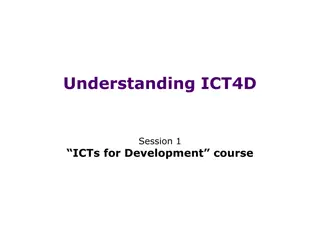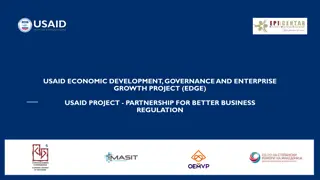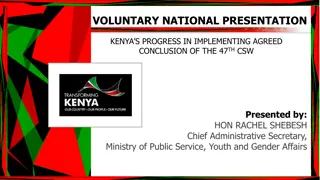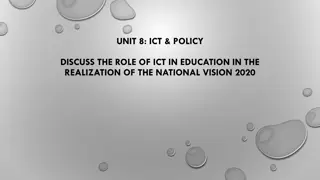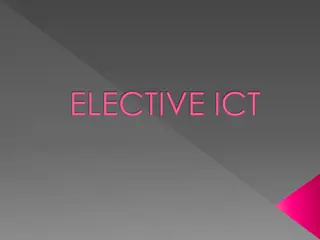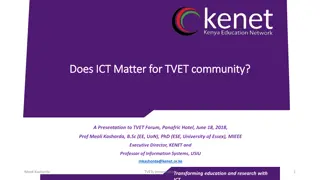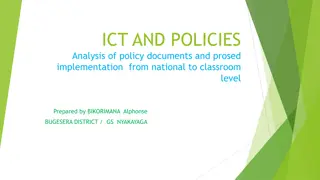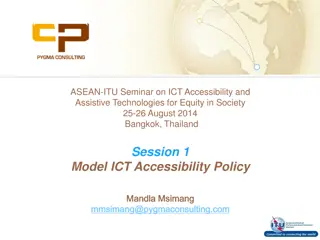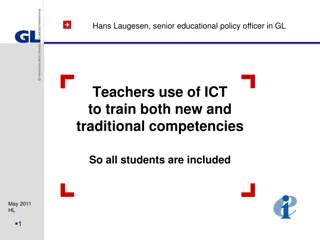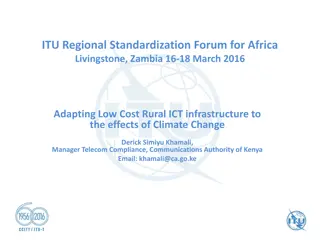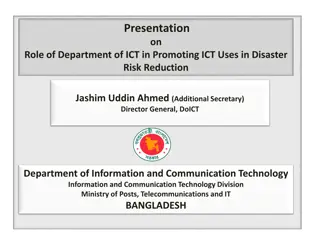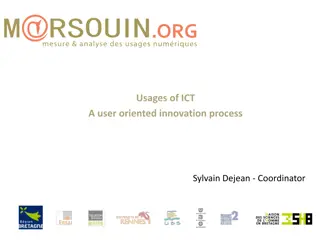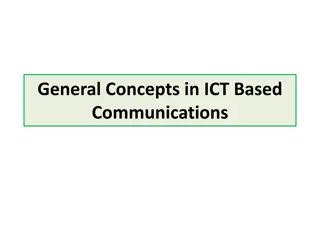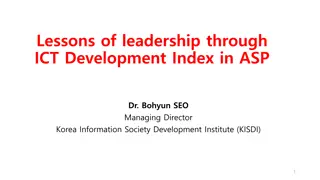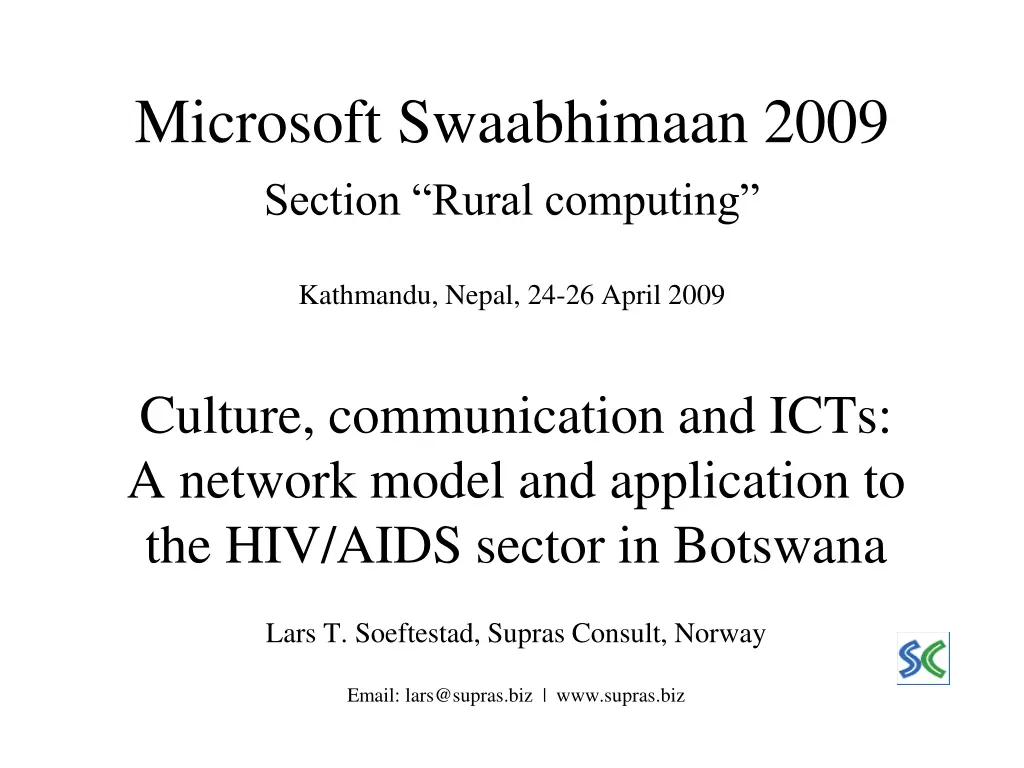
Culture, Communication, and ICTs: A Network Model for HIV/AIDS Sector in Botswana
Explore the network model and application of ICTs in the HIV/AIDS sector in Botswana as discussed at the Microsoft Swaabhimaan 2009 conference in Nepal. The thesis delves into the role of ICTs in assessing communication, knowledge, and network analysis to address imbalances and promote information flow.
Download Presentation

Please find below an Image/Link to download the presentation.
The content on the website is provided AS IS for your information and personal use only. It may not be sold, licensed, or shared on other websites without obtaining consent from the author. If you encounter any issues during the download, it is possible that the publisher has removed the file from their server.
You are allowed to download the files provided on this website for personal or commercial use, subject to the condition that they are used lawfully. All files are the property of their respective owners.
The content on the website is provided AS IS for your information and personal use only. It may not be sold, licensed, or shared on other websites without obtaining consent from the author.
E N D
Presentation Transcript
Microsoft Swaabhimaan 2009 Section Rural computing Kathmandu, Nepal, 24-26 April 2009 Culture, communication and ICTs: A network model and application to the HIV/AIDS sector in Botswana Lars T. Soeftestad, Supras Consult, Norway Email: lars@supras.biz | www.supras.biz
Content Abstract Theses Communication, Knowledge, Knowledge systems, and Knowledge management Networks and network analysis: A network model Case: HIV/AIDS sector in Botswana, Description Case: HIV/AIDS sector in Botswana, Analysis Conclusions Swaabhimaan 2009 Nepal, 24-26 April Lars Soeftestad, Supras Consult, Norway 2
Abstract and Theses Assess role & impact of ICTs by means of network analysis. That is, focusing on actors, their interests, and their ability to achieve goals Thesis 1: Networks have built-in imbalances that prevent free flow of information Thesis 2: ICTs tend to overlay such imbalances, and to reinforce them Swaabhimaan 2009 Nepal, 24-26 April Lars Soeftestad, Supras Consult, Norway 3
Communication and knowledge What is communication? Communication before and today Communication and development cooperation Knowledge and knowledge mgmt. Knowledge systems Knowledge mgmt. and development cooperation Development theories and communication Communicating knowledge Swaabhimaan 2009 Nepal, 24-26 April Lars Soeftestad, Supras Consult, Norway 4
A network model, I Network and network analysis defined Elements of networks: Actors and links Developments, I Scaling up Micro-macro relationships: Realities and models Globalization Swaabhimaan 2009 Nepal, 24-26 April Lars Soeftestad, Supras Consult, Norway 5
A network model, II Developments, II: The World Bank From actor to stakeholder Social assessment Stakeholder analysis Identifying key stakeholders Determining importance and influence Selecting representation Organizational and institutional analysis Swaabhimaan 2009 Nepal, 24-26 April Lars Soeftestad, Supras Consult, Norway 6
A network model, III Characteristics of networks Structural characteristics Size, Density, Composition Interactional characteristics Content, Direction, Stability, Frequency Conceptual apparatus Individual level Actor, Action, Category, Corporation, Cross pressure, Role, Role conflict, Status, Transaction Societal level Division of work, Institutionalisation, Integration, Culture, Norm, Process, Scale, Social structure, Social field, Social system Swaabhimaan 2009 Nepal, 24-26 April Lars Soeftestad, Supras Consult, Norway 7
A network model, IV Types of network analysis Individual-oriented approaches Contextual approaches Partial approaches Imbalances and power in networks Swaabhimaan 2009 Nepal, 24-26 April Lars Soeftestad, Supras Consult, Norway 8
Case: Description, I Why the HIV/AIDS sector in Botswana? Large foreign presence: Personnel, technology Medical approaches and technology imported Partly advanced use of ICTs Botswana statistics Poverty and social indicators ( slides 10-11) ICTs ( slides 12-13) HIV/AIDS ( slides 14-15) Swaabhimaan 2009 Nepal, 24-26 April Lars Soeftestad, Supras Consult, Norway 9
Case: Description, II Botswana, Poverty and social indicators, I Indicator Botswana, 2000-2001 1.6 3,630 1.7 Sub-Saharan Africa, 2001 673.9 470 2.5 Upper-middle income, 2001 503.7 4,460 1.3 Population (millions) GNI/capita (US $) Aver. annual pop. growth (%) Urban pop. (%) Life expectancy (yr) 49 39 32 47 77 71 Source: World Bank Swaabhimaan 2009 Nepal, 24-26 April Lars Soeftestad, Supras Consult, Norway 10
Case: Description, III Botswana, Poverty and social indicators, II Indicator Botswana, 2000-2001 Sub-Saharan Africa, 2001 Upper-middle income, 2001 Infant mortality (per 1,000 live births) Child malnutrition (%) 58 91 24 17 9 Access to improved water source (%) Illiteracy (%) 55 87 22 37 10 Gross primary enrollment (yr) 108 78 127 Source: World Bank Swaabhimaan 2009 Nepal, 24-26 April Lars Soeftestad, Supras Consult, Norway 11
Case: Description, IV Botswana, ICTs, I Indicator Botswana 1995 Botswana 2000 Sub- Saharan Africa 14 Upper- middle income 190 Phone mainlines (per 1000) Phone mainlines, large cities (per 1000) Mobile phones (per 1000) Daily newspapers (per 1000) Radios (per 1000) 41 93 168 180 33 202 0 123 27 17 12 160 95 31 130 155 198 457 Source: World Bank Swaabhimaan 2009 Nepal, 24-26 April Lars Soeftestad, Supras Consult, Norway 12
Case: Description, V Botswana, ICTs, II Indicator Botswana 1995 Botswana 2000 Sub- Saharan Africa 59 9.2 Upper- middle income 317 58.9 Television sets (per 1000) Personal computers (per 1000) Internet users (thousands) 19 10.3 25 37.0 1.0 15.0 3,695 26,350 Internet, service provider access charge (per 1000) Internet, phone user access charge (per 1000) 14.7 35.6 20.4 0.14 0.53 0.42 Source: World Bank Swaabhimaan 2009 Nepal, 24-26 April Lars Soeftestad, Supras Consult, Norway 13
Case: Description, VI Botswana, HIV/AIDS, I The HIV infection rate for the adult population is around 37 % Source: UNAIDS, NACP Swaabhimaan 2009 Nepal, 24-26 April Lars Soeftestad, Supras Consult, Norway 14
Case: Description, VII Botswana, HIV/AIDS, II Area Site 1993 (%) 1995 (%) 1997 (%) 1999 (%) Rural Chobe Lobatse Malapye Serowe/Palapye Francistown Gaborone 18.3 17.8 37.9 38.9 38.3 33.7 28.2 34.4 42.9 34.0 50.8 31.3 32.0 41.8 42.7 37.1 Urban 34.3 19.2 39.6 28.7 Source: UNAIDS, NACP Swaabhimaan 2009 Nepal, 24-26 April Lars Soeftestad, Supras Consult, Norway 15
Case: Description, VIII Identifying stakeholders Levels and sectors Levels: International, local, national Sectors: Civil society, private/commercial, public Categories of stakeholders baprofiti (prophets), BONASA, clinics, dingaka (healers), District Councils, doctors, donors, health centers, hospitals, international NGOs, Ministries, NACA, national/local CSOs, pharmaceutical companies, research institutions Swaabhimaan 2009 Nepal, 24-26 April Lars Soeftestad, Supras Consult, Norway 16
Case: Description, IX Identifying links between stakeholders The resulting network Centers of communication concentration International level Facilitating / mediating National level Local level Types of stakeholder involvement Determining Recipient / end user Swaabhimaan 2009 Nepal, 24-26 April Lars Soeftestad, Supras Consult, Norway 17
Case: Analysis, I Connecting stakeholders Importance and influence ( slide 19) Who is connected to whom? ( slide 20) Analysing links: Identifying the key stakeholders Stakeholders and use of ICTs ( slides 21-22) A clear pattern Networks and sub-networks ( slide 23) Causes and explanatory factors Swaabhimaan 2009 Nepal, 24-26 April Lars Soeftestad, Supras Consult, Norway 18
Case: Analysis, II Stakeholders: rel. importance & influence Influence of stakeholders Importance of stakeholders Un- known Little/no importance Some importance Significant importance Unknown Little/no influence Civil society org. (CSOs) The poor/ill, Local govt., Dingaka, Baprofiti, CSOs Some influence Significant influence Govt., Donors, Intl. expertise Donors Swaabhimaan 2009 Nepal, 24-26 April Lars Soeftestad, Supras Consult, Norway 19
Case: Analysis, III Who is connected to whom? President GlaxoSmith- Kleine Govt. of Botswana US Military HIV Research Program ANRS (France) Wyeth Lederle Vaccines Harvard AIDS Institute Min. of Health Botswana-Harvard AIDS Partnership NACA Hospitals, clinics, etc. CSOs Swaabhimaan 2009 Nepal, 24-26 April Lars Soeftestad, Supras Consult, Norway 20
Case: Analysis, IV Stakeholders and use of ICTs: Levels Level Voice Posters Phone Fax Radio Conf TV E- mail Cell Inter -net Local Natl. Intl. Swaabhimaan 2009 Nepal, 24-26 April Lars Soeftestad, Supras Consult, Norway 21
Case: Analysis, V Stakeholders and use of ICTs: Sectors Sector Voice Posters Phone Fax Radio Conf TV E- mail Cell Inter -net Civil society Public Private Swaabhimaan 2009 Nepal, 24-26 April Lars Soeftestad, Supras Consult, Norway 22
Case: Analysis, VI Networks and sub-networks international sub-network Communication divide natl., modern sub-network Communication divide natl./local, trad. sub-network Swaabhimaan 2009 Nepal, 24-26 April Lars Soeftestad, Supras Consult, Norway 23
Conclusions, I Communication, cultures, and constraints Existing communication bottlenecks ICTs overlayed Existing bottlenecks reinforced (and new ones created) Approach: Analyze context, that is, do a network analysis, before proceeding to plan and implement use of ICTs Consider the whole range of ICTs ICTs to be optimally adapted to local situations ICTs to connect people and issues, not the opposite Swaabhimaan 2009 Nepal, 24-26 April Lars Soeftestad, Supras Consult, Norway 24
Conclusions, II Rethoric question: Do ICTs represent value added to existing ways and means of communicating? If answer is yes , proceed to adopt and adapt ICTs, communication, and models ICT and governance Accountability Civil and political rights Inclusion Transparency Swaabhimaan 2009 Nepal, 24-26 April Lars Soeftestad, Supras Consult, Norway 25


